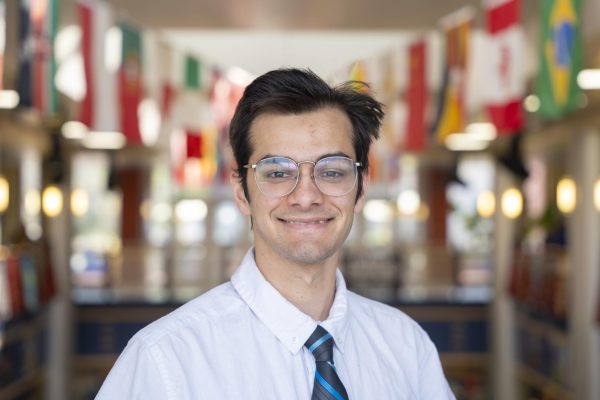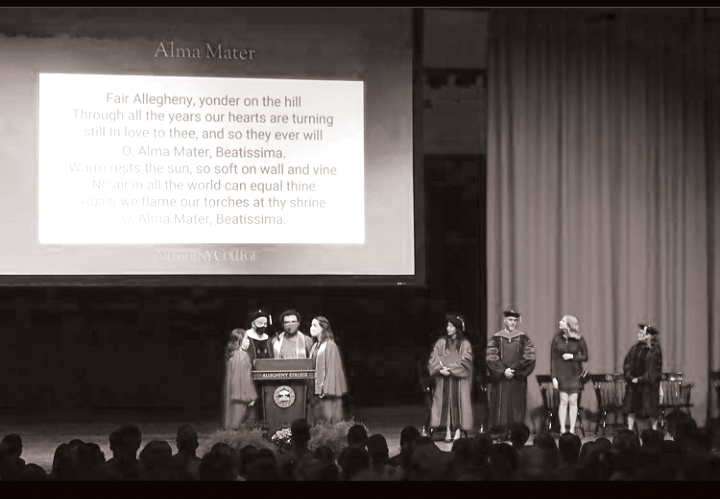‘A new tradition’: Allegheny introduces Class Assemblies
@alleghenycollege on Instagram
Professor James Niblock and three choir students introduce the Class of 2024 to Allegheny’s Alma Mater, a tradition the second-years were denied last year because of COVID-19 restrictions.
Matriculation is the traditional beginning of students’ academic journey at Allegheny College. Last year, pursuant to COVID-19 health guidelines, the ceremony was conducted virtually as a prerecorded message from President Hilary Link. This year, matriculation returned in-person and unmasked — bringing with it class assemblies for the other three academic years. The first and second-years met on Saturday, Aug. 21, while the junior and senior classes met Monday, Aug. 23.
According to First Year Class Dean Niki Fjeldal, matriculation — or convocation as it is known at some schools — is a key way for the college to kick-start the student experience.
“Matriculation during the first year is very much focused on setting the stage for us in terms of the Allegheny community and welcoming them to the academic community,” Fjeldal said. “I think it’s really important to not just be an Allegheny student, but have a ceremonial Allegheny experience and welcome you to the academic community.”
Dean for Student Success Ian Binnington noted that the sophomore class assembly in particular was designed to make up for last year’s student experience. That assembly included a class photo and the singing of the alma mater, traditions typically reserved for first-year matriculation.
“One of our goals was to have the sophomore class at least experience some of the things they couldn’t experience last year,” Binnington said. “The bigger picture, and I think this is the thing we’re going to want to continue doing, we need to think about how we welcome all students back to campus.”
Beyond the assemblies, Binnington pointed to the move-in process as another way the college is trying to welcome the entire school back.
“We usually do this big move-in event for first year students; we did it for all students this year,” Binnington said. “We had folks to help them move in and again I would anticipate us continuing to do that. It’s a big lift on our part in terms of getting the staff to do it, but it really sets a tone. We get told so many times, particularly by parents who have students at other colleges and universities … that we are just friendlier, that we are more welcoming, and they just really feel like there’s a great sense of community that they’re coming into.”
According to Ryan Sesler, ’23, however, third- and fourth-year students do not see the assemblies as a part of that school-wide welcome, noting most juniors didn’t attend their assembly.
“They didn’t find a purpose for (the assembly),” Sesler said. “It wasn’t ‘required.’ There are a few people that I know of that chose to not come and of course that I will be the one filling them in or that someone else will fill them in, but it would have been nice to see most of the junior class there.”
However, Sesler does not think that the attendance (or lack thereof) will translate to other events later in the semester.
“Definitely if we’re talking about football games or WingFest or things of that nature, I think people will be coming out,” Sesler said. “It’s just I don’t think that a lot of people want to spend the last day before classes start sitting in Shafer listening to people talk.”
The assemblies themselves were unusual for the pandemic. First, students gathered on the second floor of the Campus Center, or ‘Main St.’ Then, they processed into the Shafer Auditorium, where they sat undistanced, unmasked, and in large numbers. According to Binnington, around 300 students attended the sophomore assembly, not including the support staff, faculty, and administrators that also were present.
Nevertheless, Binnington insisted that the assemblies were safe for all who participated. He noted that the events were limited to the Allegheny community, of which vaccination status is a known quantity.
“I discussed the class assemblies with Dr. Morrow like four or five times as different CDC guidance came out,” Binnington said. “Remember that among the student population, we’re talking about 99-point-something % vaccination. Among faculty, we’re talking vaccinations in the mid-90s. If you compare us to the situation in Crawford County right now, we are about twice as vaccinated.”
Sesler is not worried about having to remask due to the delta variant, given that the college has already done so for a full academic year.
“I have no problem putting on another mask so long as I can keep having classes in person,” Sesler said. “Online learning just is not something that works for me, so having in-person classes is very important. If I have to wear a mask to have that, then so be it.”
Binninngton hopes that by next fall, the class of 2026 will matriculate with their parents and family members present, but noted that such a decision will have to wait until the nation’s vaccination and public health status becomes clearer.

Sami Mirza is a senior from many different places. He is majoring in International Studies with a focus on the Middle East and North Africa and minor in...









